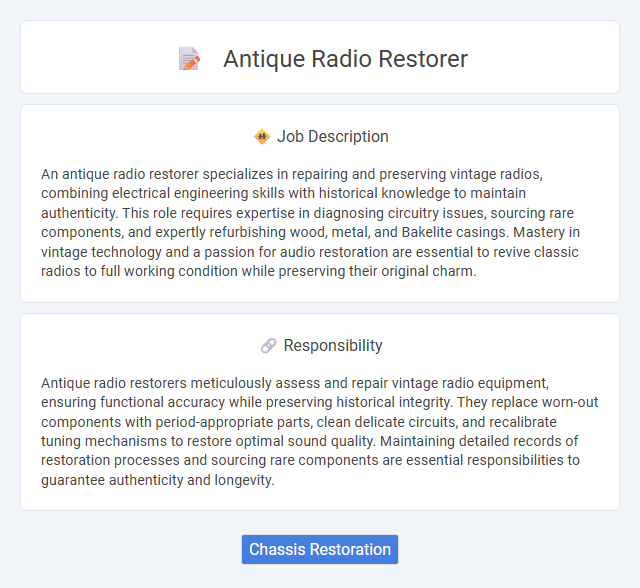
An antique radio restorer specializes in repairing and preserving vintage radios, combining electrical engineering skills with historical knowledge to maintain authenticity. This role requires expertise in diagnosing circuitry issues, sourcing rare components, and expertly refurbishing wood, metal, and Bakelite casings. Mastery in vintage technology and a passion for audio restoration are essential to revive classic radios to full working condition while preserving their original charm.
Individuals with a keen eye for detail and patience are likely suitable for an antique radio restorer role, given the intricate nature of repairing delicate vintage components. People who enjoy problem-solving and working with their hands may find fulfillment and success in this job, whereas those who prefer fast-paced or less meticulous tasks might struggle. The job could also demand physical steadiness and good vision, making it less suitable for those with certain physical or sensory impairments.
Qualification
Expertise in vintage electronics and a deep understanding of analog radio components are crucial for an antique radio restorer. Proficiency in soldering, circuit diagnosis, and knowledge of historical radio models enhances restoration accuracy and preserves authenticity. Patience and attention to detail ensure the careful handling of fragile parts and the successful revival of classic radio sound quality.
Responsibility
Antique radio restorers meticulously assess and repair vintage radio equipment, ensuring functional accuracy while preserving historical integrity. They replace worn-out components with period-appropriate parts, clean delicate circuits, and recalibrate tuning mechanisms to restore optimal sound quality. Maintaining detailed records of restoration processes and sourcing rare components are essential responsibilities to guarantee authenticity and longevity.
Benefit
Restoring antique radios likely provides a unique opportunity to preserve and revive historical technology, offering a sense of accomplishment and connection to the past. The job may enhance technical skills and knowledge in electronics, which could be beneficial for career growth or personal satisfaction. It could also open avenues for niche market sales or collaborations with collectors, potentially increasing financial rewards.
Challenge
Restoring antique radios likely presents significant challenges due to the scarcity of original parts and the delicate nature of vintage electronics. The restorer probably needs in-depth knowledge of historical circuit designs and may face difficulties diagnosing issues without modern diagnostics tools. Mastery of both electrical engineering and historical research is often essential to preserve authenticity while ensuring functionality.
Career Advancement
Antique radio restorers develop specialized skills in electronics repair and historical preservation, enabling career growth into expert technician roles or museum curation. Mastery of vintage circuitry and sourcing rare components enhances reputation, leading to opportunities as consultants or instructors in restoration workshops. Advancing in this niche field often involves building a portfolio of successful restorations and engaging with collector communities to expand professional networks.
Key Terms
Chassis Restoration
Chassis restoration in antique radio repair involves careful disassembly, cleaning, and replacement of corroded or damaged components to ensure electrical safety and functionality. Precision soldering and rewiring maintain original circuit integrity while updating parts to modern standards without compromising authenticity. Expertise in identifying vintage components and troubleshooting facilitates the revival of classic radios to working condition, preserving historical value.
 kuljobs.com
kuljobs.com